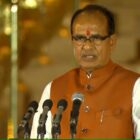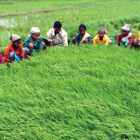India ignores science when dealing with both climate change and food security/GM crops. The first needs a top-down approach and achieving food security needs a bottom-up approach.
For an Indian farmer cocooned in his world of traditional cultivation, it is difficult to consider food security in global terms. For poor farmers generally suffering from hunger, food and nutrition deficiency, food security is essentially a matter of survival at an individual, family farm level. Yet in an era of climate change, food security is a matter of national and international attention and there is large scale transfer of grain across borders, be it across continents, nations or regions within a country itself. Even the United Nations has declared 2014 as the year of family farms.
There are some basic flaws in the thinking around grain transfers. Not only do they affect regional biodiversity, it is not practical to feed farmers by aid, trade or large-scale grain movements. Food security initiatives that distribute subsidised grains from elsewhere exacerbate the problem. Local food and varieties lose out and are sometimes lost forever. This is one of the prime causes of farming distress as prices of local farm produce in the host countries get depressed, compelling farmers to engage in monoculture with excessive use of inputs.
Small farmers can be hand-held into growing vegetables in their own backyards along with some livestock rearing. This is a perfect combination to attain nutrition security, a much-neglected but critical need. Regrettably, nutrition finds a small mention in the millennium development goals. Many of these problems need out-of-the-box thinking. A family can grow its own vegetables over land measuring no more than a large-sized room. Combining the backyard garden with livestock rearing; with a small solar panel and a biogas unit for cooking gas and elementary electric power that lights a bulb and recharge phones is a feasible idea.
In the age of climate change, agriculture needs to be sustained. Surprisingly, at the January 2014 meet of the World Economic Forum (WEF) some skeptics dismissed the climate change threat. If only politicians gave as much attention to climate change as they give to genetically modified (GM) crops, the world would be a better place. Curiously, science is ignored in both cases of climate change and GM crops. Dealing with climate change needs a top down approach while achieving food security needs a bottom up approach.
The world faces the prospect of a 4°C rise in global temperatures, courtesy unsustainable development practices in the developed world, to begin with. The guilty should foot a part of the bill with a 10-year commitment of $100 billion annually to mitigate environmental impact, especially in the developing world. That would be responsible behaviour. The world can ignore the climate change danger only at its peril. The question is whether the earth is becoming hotter by four per cent and if it can be limited to two per cent? The imagery that comes to mind is that of a bus with faulty brakes hurtling down a steep slope, the passengers asleep, oblivious that the end is nigh. Cut to the reality of politicians driving that bus with citizens of the world as the passengers.
This is everyone’s worst nightmare. Today, the global population is not just interconnected but interdependent as well. It is clear that the erroneous ways of the past will catch up with mankind. Matters are hardly helped with developing countries following the developed in terms of unsustainable industrial activity and lifestyles.
At the WEF, climate resilience was described differently by different people. To my mind it is the capacity to recover from shocks. Farms in Europe are more climate resilient while farmers in the developing world are more resilient to pain. If the climate keeps changing, everyone will fall but it will be harder for those who fall from a higher branch.
While the developed world is thinking of a 40 per cent emission reduction, the developing countries are more focused on misplaced economic growth indicators such as increased GDP and will not forego economic growth for the sake of environment impact mitigation on a large scale. Their priorities at the moment are different; development and employment generation make up the agenda. Returns on environment investment are a long way off; indeed too long term to attract investment from financially stunted governments.
Where does the farmer fit in all this? Environmentally sustainable interventions have to be economically viable in the immediate term for farmers to adopt and make scalable. Their parlous socio-economic condition does not allow adoption of environmentally sustainable practices whose benefits accrue over a period of time. The world has other problems too with wheat, maize and rice supplying more than 60 per cent of the calories for global intake while other crops are underutilised. The world food supply is precariously reliant on a very small number of carbohydrate-rich crops resulting in overwhelming health costs.
This is where global research should step in. The CGIAR (formerly the Consultative Group on International Agricultural Research) must integrate newer crop varieties into its research agenda. Even the private sector restricts its agri-research investment to a few crops. More investment is needed in vegetables, fruits, fish, livestock and other agricultural products to deal with malnutrition. Horticulture contributes five times more jobs than other agriculture activity and puts useful food into empty stomachs and that should account for a lot. The bottomline is that feeding the world without nourishing it is not the consummation that one desires.




